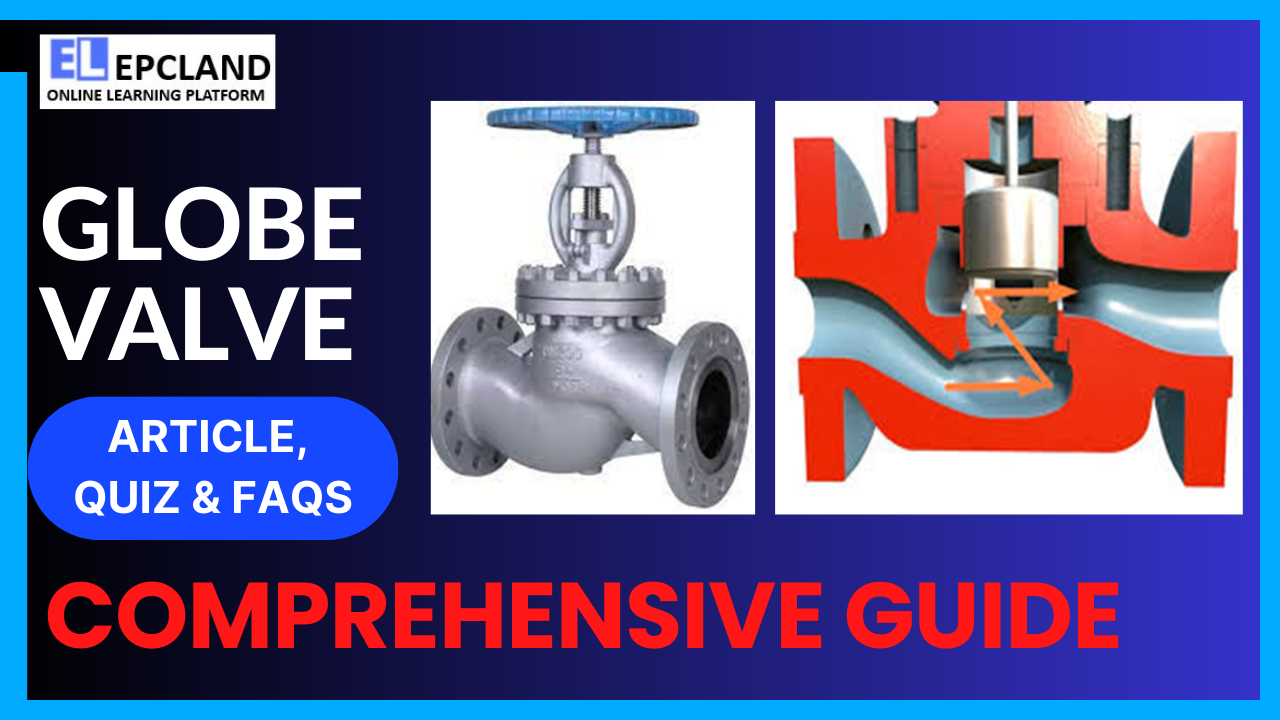1. Introduction
Globe valves are fundamental components in the world of engineering, facilitating precise control over fluid flow within various systems. These valves find applications in industries ranging from oil and gas to pharmaceuticals, playing a pivotal role in ensuring the smooth operation of diverse processes. Understanding the intricacies of globe valves, including their history, working principles, types, and applications, is essential for engineers, technicians, and enthusiasts alike.
Table of Contents
Don’t miss the Complete Course on Piping Engineering: Check Now
Enrollment Link
2. Brief History
Evolution of Globe Valves
The concept of globe valves dates back centuries, evolving in tandem with human understanding of fluid dynamics. Historically, early globe valves were rudimentary, primarily crafted from wood and operated manually. Over time, as metallurgy advanced, these valves transitioned to more durable materials, enhancing their efficiency and reliability. The 19th century witnessed significant advancements, including the introduction of stem-guided globe valves, marking a milestone in valve technology.
Landmark Developments
One of the key advancements was the invention of the T-pattern globe valve, a design that significantly improved flow control. Later, the Y-pattern and angle-pattern globe valves emerged, each catering to specific applications. With the rise of industrialization, globe valves became integral components in steam engines, allowing precise regulation of steam flow and contributing to the Industrial Revolution.
3. Basic Function and Working Principle
Globe valves operate on a straightforward yet effective principle. The valve consists of a movable disk (or plug) that regulates the flow of fluid through a stationary ring seat. By adjusting the position of the disk concerning the seat, the flow can be precisely controlled. When the valve is fully open, the disk is lifted entirely away from the seat, allowing unrestricted flow. Conversely, when fully closed, the disk forms a seal against the seat, preventing any flow.
Valve Positioning System
Modern globe valves employ various positioning systems, including manual hand wheels, pneumatic actuators, and electric motors. These systems provide operators with the ability to fine-tune the flow, making globe valves indispensable in applications where accuracy is paramount.
4. Main Components
Globe valves consist of several crucial components, each contributing to their functionality and reliability.
Valve Body
The body forms the outer shell of the globe valve, providing structural support and housing the internal components. Materials for valve bodies vary, with common choices including stainless steel, cast iron, and bronze. The selection depends on factors such as fluid type, pressure, and temperature.
Disc, Stem, Seat, Bonnet
- Disc: The disc, also known as the plug, controls the flow by moving closer to or away from the seat. It is typically made from materials resistant to wear and corrosion.
- Stem: The stem connects the handwheel or actuator to the disc, transmitting the motion to control the flow. Proper stem alignment is crucial for efficient valve operation.
- Seat: The seat provides a sealing surface for the disc. It is often replaceable, allowing for maintenance without replacing the entire valve.
- Bonnet: The bonnet covers the valve’s internals, protecting them from external elements. It also houses the stem and provides a leak-proof seal.
Material Choices and Their Significance
The choice of materials for these components is critical, ensuring resistance to corrosion, erosion, and high temperatures. Stainless steel, brass, and exotic alloys are common materials used, each selected based on the specific application requirements.
5. Types of Globe Valves
Globe valves come in various configurations, each tailored to specific applications.
T-pattern Globe Valves
T-pattern globe valves feature a linear flow path, making them suitable for applications where minimal pressure drop is essential. They are commonly used in systems requiring precise throttling.
Y-pattern Globe Valves
Y-pattern globe valves offer higher flow capacities compared to T-pattern valves. Their design allows for efficient handling of high-pressure drops, making them ideal for applications involving dense fluids or gases.
Angle-pattern Globe Valves
Angle-pattern globe valves have an angled body, allowing for a change in the direction of flow. This design is advantageous in tight spaces where a straight-line flow path is not feasible.
Bellows-sealed Globe Valves
Bellows-sealed globe valves incorporate a bellows element, providing a secondary seal against leakage. This design is crucial for applications involving hazardous or toxic fluids, ensuring safety and environmental protection.
Screw-in Bonnet Globe Valves
Screw-in bonnet globe valves feature a threaded bonnet, enhancing the valve’s structural integrity. They are commonly used in high-pressure and high-temperature applications, providing reliable performance under extreme conditions.
6. Application of Globe Valves
Globe valves find extensive applications across diverse industries, owing to their versatility and precision.
Oil and Gas Industry
In the oil and gas sector, globe valves regulate the flow of crude oil, natural gas, and various petroleum products. They are vital components in pipelines, refineries, and offshore platforms, ensuring safe and efficient operation.
Water Treatment Plants
Globe valves play a crucial role in water treatment facilities, managing the flow of water, chemicals, and sludge. Their ability to provide accurate flow control contributes to the effectiveness of water purification processes.
Power Generation
In power plants, globe valves control the flow of steam and other fluids within boilers, turbines, and condensers. Precise regulation is essential for optimizing energy efficiency and ensuring reliable electricity generation.
HVAC Systems
Heating, ventilation, and air conditioning (HVAC) systems utilize globe valves to control the flow of hot or chilled water, maintaining optimal indoor temperatures. These valves enable precise adjustments, enhancing comfort and energy efficiency.
Pharmaceutical Industry
In pharmaceutical manufacturing, globe valves are used to handle various chemicals and pharmaceutical products. Their sanitary design and accurate flow control make them indispensable in ensuring product quality and safety.
Marine and Shipbuilding
Globe valves are employed in marine applications, regulating the flow of seawater, fuel, and other fluids within ships and offshore platforms. Their robust construction and resistance to corrosion are vital for maritime operations.
Don’t miss the Complete Course on Piping Engineering: Check Now
Enrollment Link
7. Relevant Picture

Caption: A typical globe valve illustrating its components and functionality.
8. Advantages & Disadvantages
| Advantages | Disadvantages |
|---|---|
| Precise Flow Control | Limited in High-Pressure Systems |
| Versatile Applications | High Pressure Drop |
| Durable and Long-lasting | Limited to Moderate Temperatures |
| Easy to Maintain and Repair | Prone to Cavitation |
| Reliable Performance | Sensitive to Contaminants |
9. Associated Codes & Standards
| Code/Standard | Description |
|---|---|
| API 602 | Standard for Small Bore Globe and Check Valves |
| ASME B16.34 | Valves-Flanged, Threaded, and Welding End |
| API 598 | Valve Inspection and Testing |
| ANSI B16.10 | Face-to-Face and End-to-End Dimensions of Valves |
| ASTM A105 | Standard Specification for Carbon Steel Forgings for Piping Applications |
Conclusion
In conclusion, globe valves stand as indispensable components in various industries, ensuring the smooth operation of critical processes. Their evolution from rudimentary designs to sophisticated, application-specific configurations reflects the relentless pursuit of efficiency and precision in engineering. As technology continues to advance, globe valves will undoubtedly play a pivotal role in shaping the future of fluid control systems, underscoring their enduring significance in the world of engineering and manufacturing.
FAQs
1. What is the primary function of a globe valve?
Globe valves are primarily used to regulate the flow of fluid in a pipeline. They achieve this by raising or lowering a movable disk (or plug) into or away from the stationary ring seat, controlling the flow of the fluid. Globe valves are ideal for applications requiring accurate throttling and precise flow control.
2. Why are there different patterns of globe valves, and how do they differ from each other?
Different patterns of globe valves, such as T-pattern, Y-pattern, and angle-pattern, exist to cater to specific flow requirements. T-pattern globe valves have a linear flow path, Y-pattern valves offer higher flow capacities, and angle-pattern valves change the direction of flow. The choice among these patterns depends on factors like pressure drop, space constraints, and the nature of the fluid being controlled.
3. What are the key considerations for selecting the right material for globe valves?
The selection of materials for globe valves is crucial and depends on the fluid being handled, operating temperature, pressure, and environmental conditions. Common materials include stainless steel, brass, bronze, and exotic alloys. Stainless steel is preferred for its corrosion resistance, making it suitable for a wide range of applications.
4. How are globe valves different from other types of valves, such as ball valves and gate valves?
Globe valves differ from ball valves and gate valves in their internal structure and flow control mechanism. Unlike ball valves, which use a rotating ball to control flow, and gate valves, which use a flat gate, globe valves utilize a movable disk and seat arrangement for precise throttling. Globe valves are excellent for fine control, whereas ball valves are better for on/off control, and gate valves are suitable for full flow or no flow situations.
5. What maintenance practices are essential to ensure the optimal performance of globe valves?
Regular maintenance is crucial for the optimal performance of globe valves. This includes periodic inspection of the valve body, disc, stem, and seat for signs of wear or corrosion. Lubricating moving parts, checking for leaks, and ensuring proper alignment of the stem are essential. Additionally, globe valves in critical applications should undergo preventive maintenance to avoid unexpected failures and downtime.
Don’t miss the Complete Course on Piping Engineering: Check Now
Enrollment Link
Recommended courses (Published on EPCLand)
- Basics of Piping Engineering
- Piping Layout Engineering
- Piping Material Engineering
- Piping Stress Analysis
- Complete Course on Piping Engineering
- Material Requisitions
- Piping Material Specifications
- Valve Material Specifications
Don’t miss the published articles on following:
Attempt Quiz
Question 1:
What is the primary function of a Globe Valve?
Explanation: Globe Valves are primarily used to regulate the flow of fluid in a pipeline.
Question 2:
What is the typical shape of the globe valve’s disk or closure element?
Explanation: The typical shape of a globe valve’s disk or closure element is Spherical.
Question 3:
Which part of the globe valve controls the flow rate?
Explanation: The Disk of the globe valve controls the flow rate by moving up and down to open or close the valve.
Question 4:
What is the advantage of a globe valve over a gate valve?
Explanation: Globe valves have better throttling ability compared to gate valves.
Question 5:
What is the function of the handwheel in a globe valve?
Explanation: The handwheel in a globe valve is used to open or close the valve.
Question 6:
Which material is commonly used for making the body of globe valves?
Explanation: Stainless Steel is commonly used for making the body of globe valves due to its corrosion resistance.
Question 7:
What is the typical range of motion for the disk in a globe valve?
Explanation: The typical range of motion for the disk in a globe valve is Linear, moving up and down to control the flow.
Question 8:
What is the purpose of the valve seat in a globe valve?
Explanation: The valve seat in a globe valve prevents leakage by providing a tight seal between the disk and the valve body.
Question 9:
Which of the following is NOT a type of globe valve?
Explanation: Globe Check Valve is not a type of globe valve. It combines the functions of a globe valve and a check valve.
Question 10:
Which industry commonly uses globe valves for various applications?
Explanation: The Oil and Gas industry commonly uses globe valves for various applications, including controlling the flow of liquids and gases.



